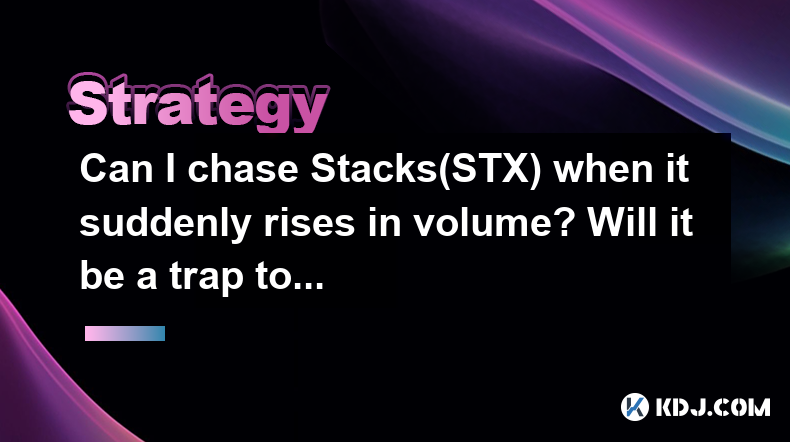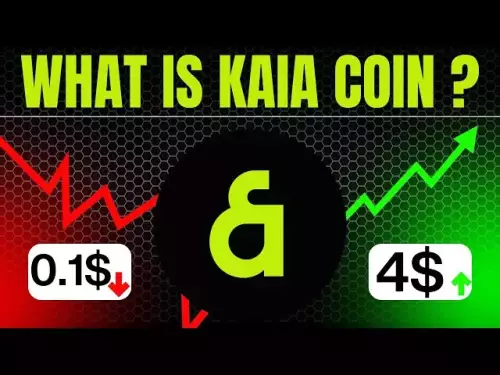-
 bitcoin
bitcoin $112715.707551 USD
-1.71% -
 ethereum
ethereum $4101.475385 USD
-3.01% -
 tether
tether $1.000644 USD
-0.02% -
 bnb
bnb $1207.619465 USD
-6.77% -
 xrp
xrp $2.501451 USD
-3.98% -
 solana
solana $202.947124 USD
-3.32% -
 usd-coin
usd-coin $1.000295 USD
0.04% -
 dogecoin
dogecoin $0.203884 USD
-4.47% -
 tron
tron $0.317154 USD
-1.72% -
 cardano
cardano $0.695009 USD
-4.43% -
 hyperliquid
hyperliquid $38.853961 USD
-8.23% -
 chainlink
chainlink $18.988674 USD
-4.64% -
 ethena-usde
ethena-usde $1.000233 USD
-0.03% -
 stellar
stellar $0.337050 USD
-3.63% -
 bitcoin-cash
bitcoin-cash $536.861728 USD
-1.28%
Can I chase Stacks(STX) when it suddenly rises in volume? Will it be a trap to lure more people?
Before chasing Stacks (STX) after a volume surge, analyze news, trading patterns, and use technical indicators to avoid potential traps and manage risks effectively.
Apr 30, 2025 at 09:29 pm

When considering whether to chase Stacks (STX) after a sudden rise in volume, it's crucial to approach the situation with a clear understanding of market dynamics and the potential risks involved. Sudden increases in trading volume can often signal significant interest in a cryptocurrency, but they can also be misleading. In this article, we will explore the factors to consider before deciding to chase STX, the potential risks of such a move, and how to identify whether the volume surge might be a trap designed to lure more investors.
Understanding Volume Surges in Cryptocurrencies
Volume surges in cryptocurrencies like Stacks (STX) can be triggered by various factors. These may include positive news about the project, partnerships, technological advancements, or even market manipulation. When you see a sudden increase in volume, it's essential to investigate the underlying cause. News and announcements from the Stacks team or related projects can often explain the surge, but it's not always the case.
To understand the volume surge, you should:
- Check recent news and announcements related to Stacks (STX).
- Analyze social media sentiment to gauge community reactions.
- Review trading data on multiple exchanges to see if the volume increase is consistent across platforms.
The Psychology of Chasing a Rising Asset
The temptation to chase a cryptocurrency like Stacks (STX) after a volume surge is driven by FOMO (Fear Of Missing Out). Investors often see the price rising and fear they will miss out on potential gains. However, this emotional response can lead to poor decision-making. It's important to approach the situation with a rational mindset and consider the following:
- Historical price movements of STX to see if similar volume surges have led to sustained gains or were short-lived.
- Market trends and whether the broader cryptocurrency market is experiencing similar movements.
- Your investment strategy and whether chasing STX aligns with your long-term goals.
Identifying Potential Traps
A sudden rise in volume can sometimes be a trap designed to lure more investors into buying at a peak price. Market manipulators may artificially inflate volume to create the illusion of increased interest, only to sell off their holdings once new investors enter the market. To identify whether the volume surge in STX might be a trap, consider the following:
- Unusual trading patterns, such as a spike in volume followed by a rapid price drop.
- Lack of fundamental news to justify the volume increase.
- High concentration of trades on a single exchange, which could indicate manipulation.
Risk Management When Chasing STX
If you decide to chase Stacks (STX) after a volume surge, it's crucial to implement risk management strategies. This can help mitigate potential losses if the price does not continue to rise as expected. Consider the following steps:
- Set stop-loss orders to automatically sell your STX if the price falls below a certain level.
- Diversify your portfolio to reduce the impact of a potential loss in STX.
- Invest only what you can afford to lose, as chasing a rising asset can be highly speculative.
Technical Analysis and Volume Surges
Technical analysis can provide additional insights when evaluating whether to chase STX after a volume surge. By examining charts and indicators, you can better understand the market's momentum and potential future movements. Key technical indicators to consider include:
- Moving averages to identify trends and potential reversal points.
- Relative Strength Index (RSI) to gauge whether STX is overbought or oversold.
- Volume indicators like the On-Balance Volume (OBV) to confirm the strength of the volume surge.
Case Studies of Volume Surges in STX
Examining past instances where Stacks (STX) experienced sudden volume surges can provide valuable lessons. For example, if STX had a significant volume increase in the past due to a partnership announcement, you could analyze how the price reacted in the days and weeks following the surge. This historical context can help you make more informed decisions about whether to chase STX in the current situation.
To conduct a case study, you should:
- Identify past volume surges in STX using historical trading data.
- Analyze the price movements following each surge to see if they led to sustained gains or were short-lived.
- Compare the current situation to past events to determine if similar patterns are emerging.
Community and Expert Opinions on STX Volume Surges
The Stacks (STX) community and cryptocurrency experts can offer valuable insights into whether a volume surge is a buying opportunity or a potential trap. Engaging with the community through forums, social media, and dedicated STX groups can provide a broader perspective on the situation. Additionally, following expert analyses and market reports can help you make a more informed decision.
To gather community and expert opinions, you can:
- Join STX-focused Telegram groups and Discord channels to discuss the volume surge with other investors.
- Follow cryptocurrency analysts on platforms like Twitter and YouTube who regularly cover STX and similar assets.
- Read market reports from reputable sources to see if they mention the volume surge in STX and their analysis of it.
Frequently Asked Questions
Q: How can I differentiate between a genuine volume surge and a manipulated one in STX?A: To differentiate between a genuine and manipulated volume surge in STX, look for consistent volume increases across multiple exchanges, check for any fundamental news or announcements that could justify the surge, and monitor for unusual trading patterns that might indicate manipulation.
Q: What are the signs that a volume surge in STX might be a short-term phenomenon?A: Signs that a volume surge in STX might be short-term include a lack of sustained price movement following the surge, a rapid return to previous trading volumes, and no significant news or developments to support the increased interest.
Q: How can I use technical analysis to confirm a volume surge in STX?A: To confirm a volume surge in STX using technical analysis, look for confirmation from indicators like the On-Balance Volume (OBV), which should show an increase in line with the volume surge. Additionally, check if the price is supported by moving averages and if the RSI indicates whether the asset is overbought or oversold.
Q: What should I do if I've already chased STX after a volume surge and the price starts to drop?A: If you've chased STX after a volume surge and the price starts to drop, consider your risk management strategy. If you have set stop-loss orders, they should help limit your losses. If not, evaluate whether to hold or sell based on your investment goals and the current market conditions.
Disclaimer:info@kdj.com
The information provided is not trading advice. kdj.com does not assume any responsibility for any investments made based on the information provided in this article. Cryptocurrencies are highly volatile and it is highly recommended that you invest with caution after thorough research!
If you believe that the content used on this website infringes your copyright, please contact us immediately (info@kdj.com) and we will delete it promptly.
- BTC, ETH, and Crypto Presales: Navigating the Storm with MoonBull & LivLive
- 2025-10-15 11:05:13
- BlackRock's Bitcoin ETF Buzz Down Under: Australia's Crypto Scene Heats Up
- 2025-10-15 11:45:15
- Trump, Bitcoin, and Trump Media: A New York Minute on Crypto's Latest Twist
- 2025-10-15 11:05:13
- Altcoin Season Incoming? Historical Setups and Trends to Watch
- 2025-10-15 11:45:15
- Crypto Scam Crackdown: Cambodian Executive, Bitcoin Seizure, and a $14 Billion Heist
- 2025-10-15 11:10:00
- Bitcoin's Wild Ride: Structural Demand Survives the Liquidation Tsunami
- 2025-10-15 11:10:00
Related knowledge

Practical parameter settings for a Bitcoin multi-timeframe moving average system
Sep 18,2025 at 10:54pm
Optimizing Timeframe Combinations for Bitcoin Trading1. Selecting appropriate timeframes is crucial when building a multi-timeframe moving average sys...

How can I filter out false breakouts in Dogecoin high-frequency trading?
Sep 22,2025 at 01:00am
Understanding False Breakouts in Dogecoin Trading1. A false breakout occurs when Dogecoin's price appears to move beyond a defined support or resistan...

Techniques for identifying tops and bottoms in the Bitcoin on-chain NVT model
Sep 20,2025 at 07:54pm
Understanding the NVT Model in Bitcoin Analysis1. The Network Value to Transactions (NVT) ratio is often described as the 'P/E ratio' of the cryptocur...

What does the surge in open interest in Bitcoincoin futures mean?
Sep 20,2025 at 11:18pm
Understanding the Surge in Dogecoin Futures Open Interest1. A surge in open interest within Dogecoin futures indicates a growing number of active cont...

How can I use the Ethereum USDT premium to gauge market sentiment?
Sep 18,2025 at 11:55pm
Understanding the Ethereum USDT Premium1. The Ethereum USDT premium refers to the price difference between USDT (Tether) traded on Ethereum-based plat...

What should I do if Ethereum staking yields decline?
Sep 20,2025 at 06:18am
Understanding the Causes Behind Declining Ethereum Staking Yields1. The Ethereum network transitioned to a proof-of-stake consensus mechanism with the...

Practical parameter settings for a Bitcoin multi-timeframe moving average system
Sep 18,2025 at 10:54pm
Optimizing Timeframe Combinations for Bitcoin Trading1. Selecting appropriate timeframes is crucial when building a multi-timeframe moving average sys...

How can I filter out false breakouts in Dogecoin high-frequency trading?
Sep 22,2025 at 01:00am
Understanding False Breakouts in Dogecoin Trading1. A false breakout occurs when Dogecoin's price appears to move beyond a defined support or resistan...

Techniques for identifying tops and bottoms in the Bitcoin on-chain NVT model
Sep 20,2025 at 07:54pm
Understanding the NVT Model in Bitcoin Analysis1. The Network Value to Transactions (NVT) ratio is often described as the 'P/E ratio' of the cryptocur...

What does the surge in open interest in Bitcoincoin futures mean?
Sep 20,2025 at 11:18pm
Understanding the Surge in Dogecoin Futures Open Interest1. A surge in open interest within Dogecoin futures indicates a growing number of active cont...

How can I use the Ethereum USDT premium to gauge market sentiment?
Sep 18,2025 at 11:55pm
Understanding the Ethereum USDT Premium1. The Ethereum USDT premium refers to the price difference between USDT (Tether) traded on Ethereum-based plat...

What should I do if Ethereum staking yields decline?
Sep 20,2025 at 06:18am
Understanding the Causes Behind Declining Ethereum Staking Yields1. The Ethereum network transitioned to a proof-of-stake consensus mechanism with the...
See all articles


























![Staking ATH: How To Stake $ATH in October 2025 with 523% APY — [Step-By-Step Guide] Staking ATH: How To Stake $ATH in October 2025 with 523% APY — [Step-By-Step Guide]](/uploads/2025/10/15/cryptocurrencies-news/videos/staking-ath-stake-ath-october-apy-stepstep-guide/68eef94d80903_image_500_375.webp)















































